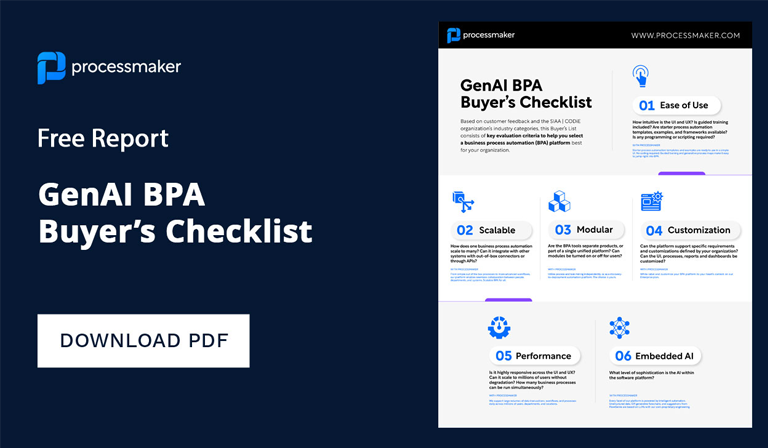The low-code movement continues to gain momentum. According to Gartner, the worldwide low-code development technologies market is projected to total $13.8 billion in 2021, representing a YoY increase of 22.6% from 2020.
Nearly a decade has passed since Forrester coined the term “low-code,” saying at the time that “Low-code platforms enable rapid delivery of business applications with a minimum of hand-coding and minimal upfront investment in setup, training, and deployment.” Low-code development platforms (LCDP) accomplish this through intuitive graphical user interfaces and configuration as opposed to traditional hand coding processes.
Since a LCDP requires little to no coding to build applications, users that have no formal knowledge or training in software development can create their own. Professional developers also benefit from low-code tools by eliminating time-consuming manual coding tasks, allowing them to focus on more valuable aspects of an application.
A low-code BPM platform combines low-code development tools with business process management capabilities. Business users can create and quickly deploy applications to accelerate the automaton of business processes. A low-code BPM includes the following capabilities:
- Business intelligence
- Process modeling
- Process analysis
- Process optimization
- Process monitoring
- Workflow automation
- Enterprise application integration
5 Key Features of a Low-Code BPM Platform
When choosing a low-code BPM platform, organizations should look for 5 key features:
1. Document Management
Document management is an important feature of a low-code BPM platform. Nearly every workflow involves documents to some extent. Paper-based processes are inefficient and prone to error. A document management system makes it easy to extract relevant information from documents eliminating time-consuming manual data entry tasks. In addition, a low-code BPM platform with a document management feature allows authorized users to quickly access stored documents, store and backup information to prevent data loss, maintain audit trails, and automatically generate documents.
2. Integration with Other Technologies
Nearly every organization relies on dozens or even hundreds of third-party applications. Disparate systems contribute to data silos and inefficiencies. A low-code BPM platform should make it easy to integrate and manage third-party apps in a single location. When choosing a low-code BPM platform, look for one that offers a built-in connector library that allows you to quickly integrate popular applications into your processes. Moreover, the platform should offer a wide variety of REST and API endpoints to incorporate BPM functionality into your external applications.
3. Visual interface
One of the key features of a low-code BPM platform is the ability to create and deploy powerful applications using a drag-and-drop interface. Rather than relying on professional developers to hand code apps, non-technical users can simply drag and drop blocks of existing code to design apps and processes with ease. When choosing a low-code BPM platform look for one that is BPMN 2.0 compliant. BPMN 2.0 is universally recognized, allows users to break down complex processes into intelligible form, and can be executed through a BPMN engine.
4. Security
With cybersecurity threats increasing in frequency and sophistication, it is more critical than ever for organizations to secure sensitive data. In 2020, some 155.8 million individuals were affected by data exposures. The repercussions of a significant data incident can be devastating. When choosing a low-code BPM platform, make sure that it offers the latest security features to protect your systems and sensitive data.
5. Reporting Tools
A low-code BPM platform with built-in reporting tools allows stakeholders to create detailed reports without the need to export data to an external system. With intuitively designed reporting tools, organizations benefit from capabilities such as tracking key performance indicators (KPIs) to identify process inefficiencies and using service level agreement (SLA) reporting to calculate the costs of delays.
ProcessMaker offers an award-winning low-code BPM platform that offers all the features listed above plus many more. Organizations located around the world rely on ProcessMaker to achieve digital transformation.





